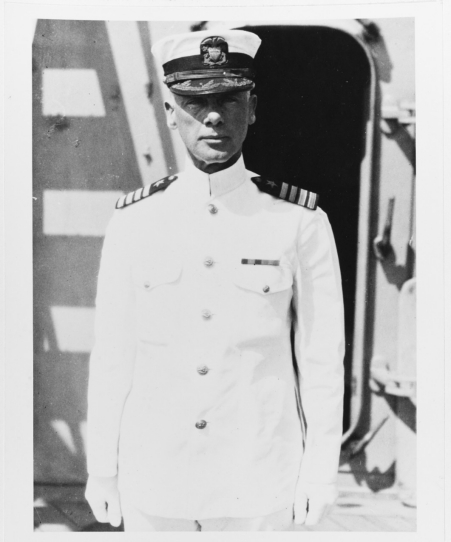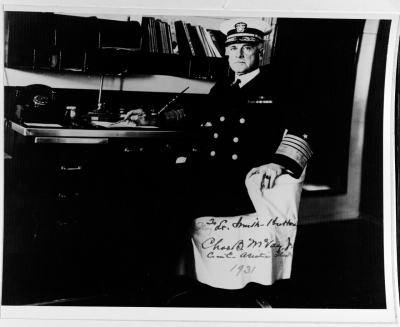Adapted from "Admiral Charles B. Mcvay, Jr., USN, Deceased," [biography, dated 25 January 1952] in Modern Officer Biographies Collection, Naval History and Heritage Command Archives, Washington Navy Yard.
- Expand navigation for Bios - A Bios - A
- Expand navigation for Anderson, Edwin Anderson, Edwin
- Expand navigation for Armstrong, Neil Alden Armstrong, Neil Alden
- Expand navigation for Bios - B Bios - B
- Expand navigation for Bean, Alan Bean, Alan
- Belknap, Reginald R.
- Bennion, Mervyn S.
- Benson, William S.
- Expand navigation for Bernatitus, Anne Agnes Bernatitus, Anne Agnes
- Boorda, Jeremy M.
- Expand navigation for Bush, George H. W. Bush, George H. W.
- Expand navigation for Bios - C Bios - C
- Expand navigation for Carpenter, Malcolm Carpenter, Malcolm
- Carter, James Earl
- Expand navigation for Cernan, Eugene Cernan, Eugene
- Expand navigation for Chaffee, Roger Chaffee, Roger
- Expand navigation for Clark, George R. Clark, George R.
- Clark, Vernon
- Expand navigation for Conrad, Charles "Pete," Jr. Conrad, Charles "Pete," Jr.
- Expand navigation for Coontz, Robert E. Coontz, Robert E.
- Cromwell, John P.
- Crowe, William James
- Expand navigation for Bios - D Bios - D
- Expand navigation for Bios - E Bios - E
- Expand navigation for Evans, Ronald Ellwin Evans, Ronald Ellwin
- Expand navigation for Bios - F Bios - F
- Fairbanks, James D.
- Expand navigation for Fechteler, Augustus F. Fechteler, Augustus F.
- Felt, Harry D.
- Expand navigation for Fletcher, Frank F. Fletcher, Frank F.
- Expand navigation for Fletcher, Frank J. Fletcher, Frank J.
- Friedell, Wilhelm L.
- Expand navigation for Bios - G Bios - G
- Expand navigation for Gleaves, Albert Gleaves, Albert
- Expand navigation for Glennon, James Glennon, James
- Expand navigation for Gordon, Richard Francis, Jr. Gordon, Richard Francis, Jr.
- Expand navigation for Grant, Albert Weston Grant, Albert Weston
- Gravely, Samuel L.
- Greenert, Jonathan W.
- Expand navigation for Griffin, Robert S. Griffin, Robert S.
- Expand navigation for Bios - H Bios - H
- Expand navigation for Hancock, Joy Bright Hancock, Joy Bright
- Expand navigation for Hasson, Esther V. Hasson, Esther V.
- Hayward, Thomas B.
- Hendrix, Henry J.
- Expand navigation for Higbee, Lenah Sutcliffe Higbee, Lenah Sutcliffe
- Holloway, James L.
- Expand navigation for Hoogewerff, John Adrian Hoogewerff, John Adrian
- Hopper, Grace Murray
- Hughes, Charles F.
- Bios - I
- Expand navigation for Bios - J Bios - J
- Johnson, Jay L.
- Expand navigation for Johnson, Lyndon Baines Johnson, Lyndon Baines
- Expand navigation for Bios - K Bios - K
- Kelso, Frank B.
- Expand navigation for Kennedy, John F. Kennedy, John F.
- Expand navigation for King, Ernest J. King, Ernest J.
- Knox, William Frank
- Expand navigation for Bios - L Bios - L
- Expand navigation for Leahy, William D. Leahy, William D.
- Expand navigation for Lovell, James Arthur, Jr. Lovell, James Arthur, Jr.
- Expand navigation for Lyle, Alexander Gordon Lyle, Alexander Gordon
- Expand navigation for Bios - M Bios - M
- Expand navigation for Mattingly, Thomas Kenneth, II Mattingly, Thomas Kenneth, II
- Expand navigation for Mayo, Henry Thomas Mayo, Henry Thomas
- Expand navigation for McCandless, Bruce, II McCandless, Bruce, II
- McDonald, David L.
- Expand navigation for McVay, Charles Jr. McVay, Charles Jr.
- Expand navigation for McVay, Charles B. III McVay, Charles B. III
- Miller, Doris
- Expand navigation for Mitchell, Edgar Mitchell, Edgar
- Morison, Samuel Eliot
- Mullen, Michael G.
- Expand navigation for Bios - N Bios - N
- Expand navigation for Niblack, Albert Niblack, Albert
- Nimitz, Chester William
- Nixon, Richard M.
- Bios - O
- Expand navigation for Bios - P Bios - P
- Bios - Q
- Expand navigation for Bios - R Bios - R
- Richardson, John M.
- Rodgers, Thomas
- Expand navigation for Rodman, Hugh Rodman, Hugh
- Roughead, Gary
- Expand navigation for Bios - S Bios - S
- Expand navigation for Schirra, Walter Marty, Jr. Schirra, Walter Marty, Jr.
- Expand navigation for Shepard, Alan Bartlett, Jr. Shepard, Alan Bartlett, Jr.
- Sherman, Forrest P.
- Expand navigation for Sims, William S. Sims, William S.
- Standley, William H.
- Stark, Harold R.
- Expand navigation for Bios - T Bios - T
- Bios - U
- Bios - V
- Expand navigation for Bios - W Bios - W
- Bios - X
- Expand navigation for Bios - Y Bios - Y
- Expand navigation for Young, John Watts Young, John Watts
- Bios - Z
- Biography
- Image (gif, jpg, tiff)
Charles Butler McVay, Jr.
19 September 1868-28 October 1949


Admiral Charles Butler McVay, Jr. graduated from the U.S. Naval Academy in 1890. During the Spanish American War he served as an officer on USS Amphitrite (Monitor No. 2), participating in the blockade of Cuba and bombardment of San Juan, Puerto Rico. McVay was the navigator of the flagship USS Alabama (Battleship No. 8) during the 1907-1909 world cruise of the Great White Fleet. Before the United States entered World War I, McVay served as Assistant to the Chief of the Bureau of Ordnance in Washington, DC. Through American involvement in WWI McVay commanded USS New Jersey (Battleship No. 16) and USS Oklahoma (Battleship No. 37), which stood ready to oppose German cruisers from Bantry Bay, Ireland. Following the war, he commanded the four destroyer escort that returned President Woodrow Wilson safely home from the Versailles Peace Treaty meetings. McVay served as Commandant of the Washington Navy Yard and Superintendent of the Naval Gun Factory in 1920 until becoming Chief of the Naval Bureau of Ordnance. While Chief of the Bureau of Ordnance, McVay oversaw many technological advancements such as modern fire control systems on ships, launching of airplanes from ships, and launching of torpedoes from airplanes. From 1923 to 1925, McVay commanded all men-of-war in the Yangtze River Patrol. Between 1929 and 1931 he was Commander-in-Chief of the U.S. Asiatic Fleet. McVay retired in 1932, but served as a member of the Navy’s General Board. He died in 1949 and is interred in Arlington National Cemetery. McVay’s son, Rear Admiral Charles B. McVay III, captained USS Indianapolis (CA-35) during her fatal final voyage in July 1945.
Full Biography [Original .pdf] [Transcription]
Footnotes
- Accessibility/Section 508 |
- Employee Login |
- FOIA |
- NHHC IG |
- Privacy |
- Webmaster |
- Navy.mil |
- Navy Recruiting |
- Careers |
- USA.gov |
- USA Jobs
- No Fear Act |
- Site Map |
- This is an official U.S. Navy web site


